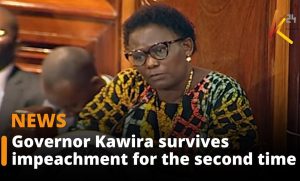The East African Community has made the most progress on integration and is the most ambitious of all regional economic communities (RECs) in Africa.
According to the latest report on regional integration by the African Development Bank, the EAC is top on the list of RECs in Africa.
“The EAC has developed a fully functional free trade area, first by implementing a Customs Union more comprehensively since July 2009, when both Rwanda and Burundi joined,” says the AfDB report.
Apart from establishing a Common Market in July 2010, AfDB says, the trade bloc’s most recent achievement on the journey towards economic union was the adoption of a protocol in 2013 outlining its plan to launch a monetary union in 10 years, a move that has not been matched by other RECs.
EAC Secretary General Amb. Dr. Richard Sezibera told The East African Digest in an interview in Arusha, Tanzania that EAC has been building a Customs Union since 2005.
He acknowledges that the EAC have since 2010 implemented the Common Market and signed the Monetary Union Protocol in November 2013, and now laying the foundations for a Political Federation of the Countries of East Africa.
Amb. Sezibera adds that implementation of the free movement of persons and labour provisions of the Common Market Protocol has received a major boost by the agreement on the use of Identity Cards as travel documents within East Africa for Burundi, Kenya, Rwanda, and Uganda.
“I have personally experienced this freedom when I crossed the Rwanda Ugandan border using my National identity which this is a remarkable benefit for East Africans from the integration process,”
The region is now in preparation for the procurement of the next generation Internationalized East African Passport expected to be issued this year.
He explained that Central Banks started implementation of an East African Payments System, allowing East Africans to use their local currencies for transactions within the region.
East Africa reached a critical integration milestone with the conclusion and signing by the Heads of State of a Monetary Union Protocol in November 2013.
“The clock is ticking on our journey towards a Single Currency for East Africa,” Dr Sezibera said.
The AfDB study assessed eight RECs including EAC, the Arab Maghreb Union (AMU), the Common Market for East¬ern and Southern Africa (Comesa), the Community of Sahara- Sahel States (CEN-SAD), the Economic Community of Central African States (ECCAS), the Intergovernmental Authority on Development (Igad), the Economic Community of West African States (Ecowas) and the Southern African Development Community (SADC).
Unlike EAC, the other blocs are in the process of establishing either a free trade area or Customs Union. Of the eight, it is only EAC that has commenced establishing a common market.
“The year 2014 left East Africa with an increasingly functional Single Customs Territory, this is a critical milestone in our integration agenda. To make this happen many stakeholders have been involved including Revenue Authorities, clearing and forwarding agents among others,” Amb. Sezibera explained.
He added that the region has experienced sustained removal of non-tariff barriers to trade and the results thereof are be¬ginning to be felt by East Africans.
Regional integration, viewed as an important factor in Africa’s economic growth and development, is a favourite agenda of the United Nations Economic Commission for Africa (Uneca).
Like AfDB, Uneca acknowledges that EAC has made progress on intra-regional trade, though there i s still room for improve¬ment.
According to Uneca, between 2000 a n d 2012 , EAC member states traded more with Africa, compared with countries belonging to other trading blocs, boasting average intra-regional export as a percentage by destination, of 19.5 %.
SADC came second with an intraregional export average of 10.9 %, followed by IGAD at 9.2 % and Ecowas coming fourth with 8.7 %.
To monitor progress made, early this year the EAC secretariat launched The East African Common Market Score Card 2014: Tracking EAC Compliance in the movement of capital, services and goods, which revealed that Tanzania and Burundi retained the highest number of restrictions to cross-border trade.
The scorecard reviews laws and regulations to gauge the level of conformity by each partner state to the Common Market Protocol that came into force in July 2010. It is one of the evaluation mechanisms that made the EAC stand out from the rest.
AfDB sees no major problem with African states belonging to more than one REC despite criticisms.
In fact, most African countries belong to more than one regional integration organisation, with only Algeria, Cape Verde and Mozambique being party to just one agreement.
“By contrast, 14 countries have signed up to two regional economic communities, 19 to three, and 16 to four. Côte d’Ivoire is a member of five regional organizations.”
According to AfDB, while overlapping membership can be costly, belonging to more than one regional economic community offers multiple benefits, since most of them were established for specific purposes rather than as a building block toward the African Economic Community.
Kenya, for example, can receive the benefits of deeper integration from its membership in the EAC, while receiving the benefits of a larger market offered by its membership to Comesa.
“Benefits may also accrue at the organisational level, with one institution benefiting from the experiences of another regional economic community that has completed a particular process through having access to its members. This may be the case for tariffs, such as the design and implementation of a common tariff nomenclature or a tariff phase-down process; a plan, such as a regional infrastructure master plan; or an instrument, such as the design and implementation of overload controls and axle-load limits,” AfDB adds in its report.
EAC’s rules of origin and FTA, for example, are based on Comesa’s and its regional over¬load control legislation is based on work done in SADC and Comesa.
However, some economists maintain that if not well managed, belonging to more than one regional economic community can be costly.
“It goes without saying that overlapping membership requires additional resources, since a particular member country will be required to participate in different activities, workshops, meetings and conferences organized by the respective trade blocs. The country in question will also be required to implement what has been agreed upon,” said strategic economist consultant Joseph Chege, who follows East African affairs.
However, AfDB says though such activities can lead to duplication and overlap, the benefits of belonging to two regional organizations may outweigh the costs and other challenges.
Some economists also argue that dual membership presents member states with multiple and different pathways to deepening regional integration.
AfDB, however, faults the eight regional economic communities in Africa for failing to make enough progress on free movement of labour.
Though mobility and migration have always been an intrinsic part of human capital development, the bank says the flows of labour in the continent are running into increasing restrictions to mobility.
“In Africa, closing doors to free movement of people has sent massive flows of undocumented people or irregular mi¬grants through the ‘windows.’ Porous borders and informal processes facilitate the act of migrating within Africa, but intra-African migrants face the disadvantages of high formal restrictions and costly barriers to mobility,” AfDB adds.
The bank wants the regional economic communities to recognize that in treaties on regional integration, with the implied goal of common or single markets, migration constitutes one of the freedoms that contribute to development.
“EAC needs to do more on free movement of labour. This is because a fully established common market needs free movement of goods, labour and services and so far we are not there yet,” says Mr Chege.
Financial integration
Dr. Sezibera said the region’s central banks started implementation of an East African Payments System, allowing East Africans to use their local cur¬rencies for transactions within the region. East Africa reached a critical integration milestone with the conclusion and signing by the Heads of State of a Monetary Union Protocol in November 2013. The clock is ticking on our journey towards a Single Currency for East Africa.
“Regional economic communities would do well to recognize regional qualifications, encourage regional pooling of skills and co-ordinate annual immigration quotas according to skills gaps in national labour markets,” AfDB says.
On financial matters, AfDB says cross-border banking activities that are led by African banks have been the most visible forms of regional financial integration.
Large South African banks (Standard Bank Group, Barclays Africa Group) are increasingly widening their presence outside South Africa. In East Africa, on the other hand, Kenyan-based banks like Equity and Kenya Commercial Bank have begun to expand.
“Equity Bank of Kenya in¬tends to expand its agent and mobile banking model to serve unbanked people in the EAC region,” the report adds.
However, AfDB says, African financial systems lack reliable information for credit screening, quality accounting practices and systems to prevent tax evasion.
“Many African countries lack efficient national credit bureaus, due to inadequate regulation, unreliability of data, lack of appropriate information technology and human resources, and lack of funding to design and implement efficient ones,” the Bank adds.
In East Africa, however, the central banks in Kenya, Tanzania and Uganda are linking up their payment systems within a broader plan to integrate their financial markets. The initiative, according to the AfDB, will facilitate money transfers within the region through a reduction in costs, and is expected to reduce entry barriers and open up the supply market for money transfers, which has so far been exclusively dominated by a few multinational companies and cross-border banks that of¬fer similar services within their subsidiaries.





